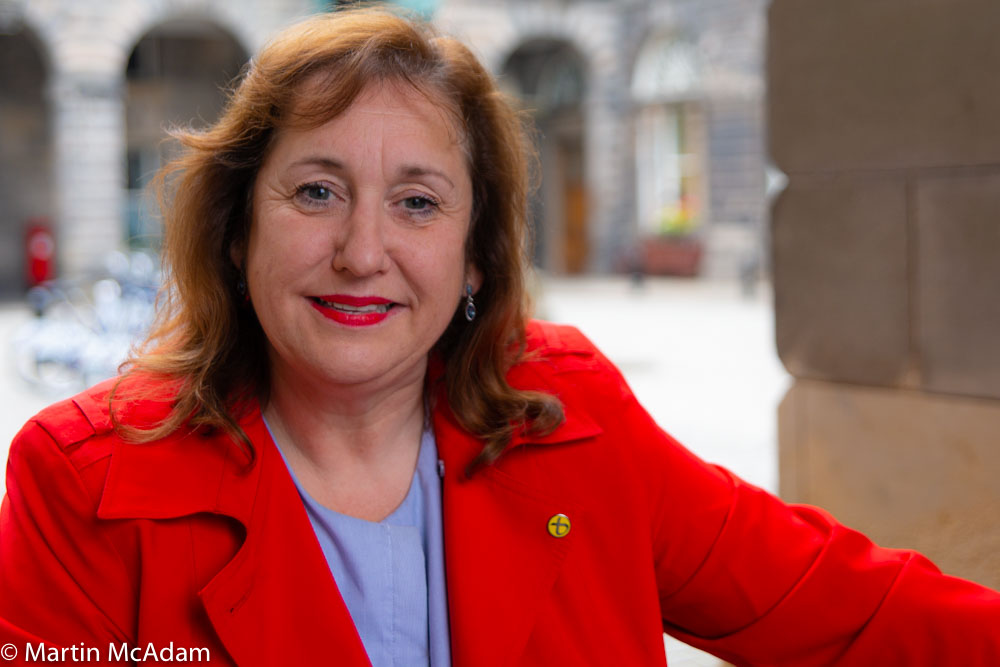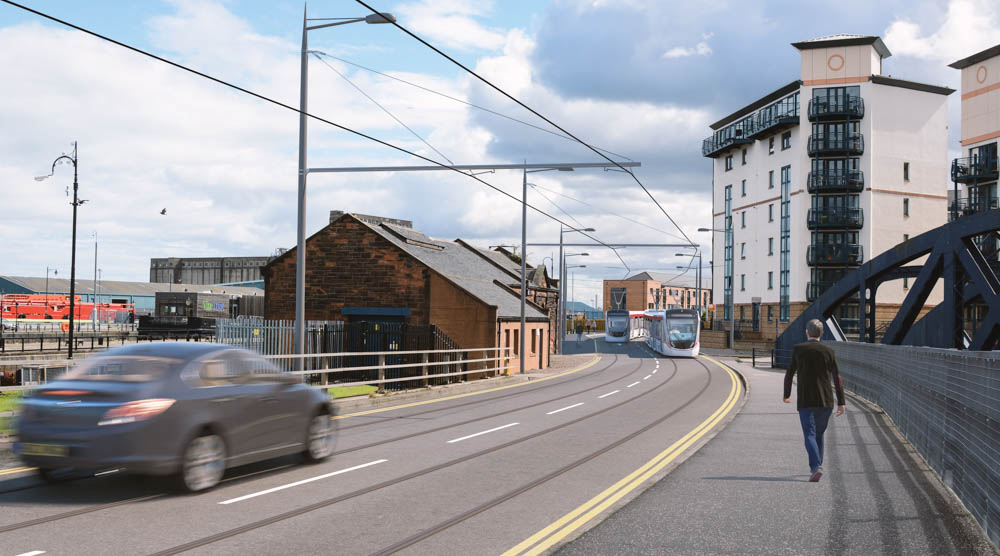Trams to Newhaven – next steps may lead to a green light
Councillors will decide on 14 March 2019 on whether or not to extend the current tram line to Newhaven which would open to passengers in the Spring of 2023.
The Final Business Case has now been published and will be considered at next week’s meeting of the Transport and Environment Committee before being passed to a meeting of all 62 councillors for approval in March.
Some elected members have already examined the FBC and supporting documents in a specially set up data room in the City Chambers, where members of the project team have also been on hand to respond to questions.
The FBC has been drafted following best practice for major capital projects from both HM Treasury (Green Book) and Scottish Government (STAG).
Having gone through a thorough tendering process, the FBC outlines that trams to Newhaven can be delivered within a budget of £196m, which includes a significant additional risk allocation on top of construction costs. Costs have risen since the Outline Business Case (approved in September 2017) partly, the council says, in response to changes to the design made after an in-depth consultation process with the local community and interest groups, as well as changes in the market to the way major infrastructure projects are priced following the collapse of major construction company,Carillion.
The £196m also includes around £2.4m in funding to support local businesses through the construction process.
Even when the recommended percentage of ‘optimism bias*’ is added, in line with government guidance, which would take the project total to £207.3m, the project remains affordable and self-financing and would not divert funds from other Council services.
The project would be funded through future tram fare revenues, along with a special dividend from Lothian Buses.
The council officers are clear that they have done everything they can to produce a robust Business Case for councillors to consider, including consulting those who have built tram systems elsewhere and major utility companies.

When the press met with the Transport Convener on Wednesday she opened the meeting by saying that this was a very exciting morning for her. She said : “These two projects will come to have a very important and strategic impact on the city and these are pivotal next steps. We have very ambitious plans for changing the way we get around the city to support our economic and population growth. This is a long term look at ways of building resilience in the city to deal with that and to improve the quality of life for those who live and work here.
“There has been an enormous amount of public interest in both of these projects during consultations.”
TRAMS TO NEWHAVEN
Tram is seen as a requirement in all stated policy. Tram is a key enabler for sustainable growth in this area. The total base cost has gone up but the overall price of £207.3 million includes what is called an optimism bias and contractor pricing inflation. We have also made design changes after the consultation last year. There is a scheme to support businesses along the route and there are two contracts : the infrastructure and systems contract and also a ‘swept path’ contract which will deal with any further utilities diversions which are required.
There will also be a period of six months for ‘early contractor involvement’. This aims for a seamless approach and will allow the council to collaborate with contractors before anyone even puts a spade in the ground. The desire is to ensure that everybody knows on day one what is happening.
The benefit to cost ratio is positive and the business case shows a £1.40 return for every £1 spent. It is not seen as being only about money of course. The administration views this as a really beneficial project.
They see it as an opportunity for housing, employment and brownfield development and will link Leith, one of the most densely populated areas in Edinburgh, and also the Waterfront where more houses will be built to other areas of Edinburgh like Edinburgh Park where there are many employment opportunities. Those jobs become more accessible and attractive with a tram connection.
AFFORDABILITY
The project is regarded as affordable and will be funded from income from tram revenue along with a special dividend of £20 million over 10 years from Lothian. The bus company has already agreed such a dividend. The estimates are that the revenue will spike in 2026-27. There will be a division of the revenue between the tram operator and the council to allow the debt to be paid off.

DELIVERY
There will be no double dig. Major utility diversions were done in 2007 but the council found in the post-mediation phase of the first part of the line at Shandwick Place for example, that a number of smaller utilities had not been cleared out.
The project team is not taking any chances this time and so the entire length of the route will be opened up to check all utilities and lay tracks
A tram project spokesperson said : “It would be naive to assume that all utilities were rerouted last time round, so we are using knowledge acquired post mediation. We have priced up on the basis of what we found in Shandwick Place and York Place.”
The difference is that the route will be dug up once, all utilities and track laying dealt with and then the contractor will move on.
The Transport Convener explained that this showed the level of caution that has been built into this project. “We have built in the worst case scenarios so that we know what we are dealing with. This caution is a keynote which has run through the last couple of years of development towards the final business case.”
BUSINESS SUPPORT
A fund of £2.4 million will support local businesses, and the council team aims to maintain the vibrancy of the area during the construction phase.
Council officers say this is about an intelligent use of funding – and a very practical one, for example to ensure that businesses can get deliveries. They are aware that this is an area where there are many pedestrians. The tram team have already gone out and talked with businesses in the area. Those conversations, which are still ongoing, have shaped the support which will be given to businesses.
Things which are favoured are window cleaning, litter picking and a full time business champion who will be appointed. Some businesses may need financial support and that will be dealt with on a case by case basis.
The work will begin in a couple of places at the same time. Leith Walk will be the main work area and they will form a large work site there. A large area of road (three lanes) will be closed off and the swept path contractor will open up as necessary to do utility diversions.
With the benefit of the Leith Street closure behind them the council realises that people get used to a diversion – as long as it does not keep changing which it did when the line from Edinburgh Airport to York Place was being constructed. Also the contractor will not necessarily stop working while work programmes are agreed. They will be able to move elsewhere and not lose time.
Construction work will complete in 2022 but as we know from last time a lot of time is then devoted to testing the line before any passengers are allowed on.
Once the construction work – except for wires and lights – has been done the road will be opened up again to traffic and the finalising work will be carried out at night. It is thought that three lanes of Leith Walk will be closed to traffic for eighteen months.
Cllr Macinnes explained that she hopes this approach will minimise disruption as far as possible.
Officers have procured a recommended contractor and this will be made public ahead of the Finance and Resources committee meeting on 7 March 2019.
On Constitution Street the City Archaeologist will be involved in excavating there as there are some Victorian graves under the street.
The Hardie Inquiry
Asked about whether there was a risk in proceeding with this extension ahead of the findings of the Edinburgh Tram Inquiry under Lord Hardie, council officers said they have already learned lessons and Cllr Macinnes replied : “The problem that we have had all along is that our two sets of timescales are not running well together. We don’t know when Lord Hardie will issue his report. We cannot justify waiting in the face of population growth in the city.
“We are not ignoring the inquiry – far from it. We are very aware of the evidence given and have tried to react to it. We have looked at lessons learned from the beginning and have been monitoring very closely the evidence which has been given. It has driven the final business case in several areas.”
The council is adopting the ‘no double dig’ approach for example which came from evidence given to the Inquiry.
Another key difference is that this has always been considered as a council project and not an arms length project. First time around there were several arms length companies involved which all became quite complex in governance terms.
PASSENGER NUMBERS
Passenger numbers are estimated to increase when the new line opens (if agreed by the council). Leith is one of the most densely populated areas and it will link this to other employment areas. The numbers also take account of the developments which are now or will be soon taking shape in an area of town that has lain fallow for the last decade.
But the thinking as to why people will use the tram and in calculating these numbers is that this line will link people to employment centres. These will be through trips rather than trips into the city centre. Even now there are people changing and linking at Haymarket.
Cllr Macinnes concluded by saying it had been a privilege to watch these cases being developed with care and caution. She explained that an independent adviser who the council had brought in to oversee the development of this project – someone with a lot of experience in light rail projects – told her that it was the most thorough approach he had seen of any business case.
She said : “We have drawn a line as to what went before. We are looking towards the future. This line will deliver enormous development opportunities, safe secure sustainable travel for many passengers. We have put a lot of caution into every step and we hope that builds confidence that we have done the best possible work we could.”
We spoke with Councillor Macinnes about the tram project and also the City Centre Transformation project. The papers for that are also published today.
Listen to our podcast here :